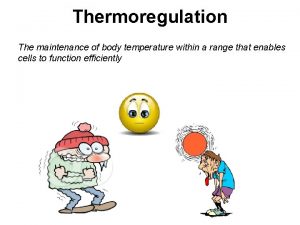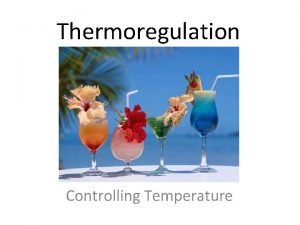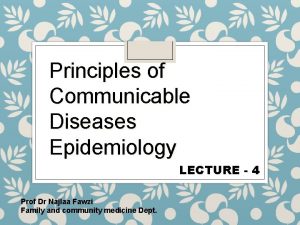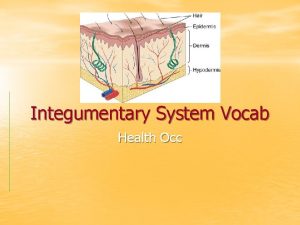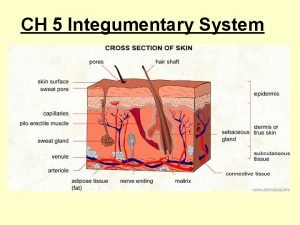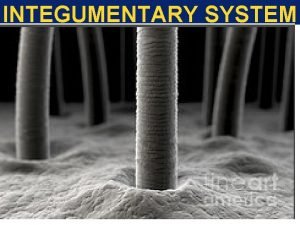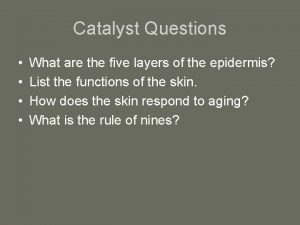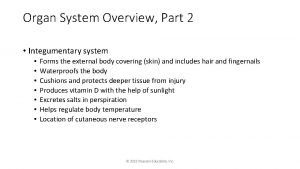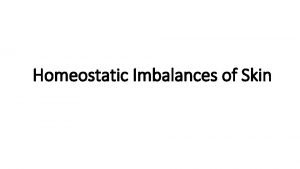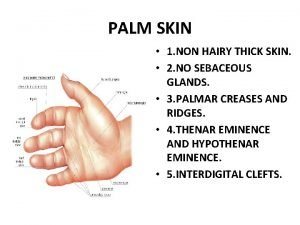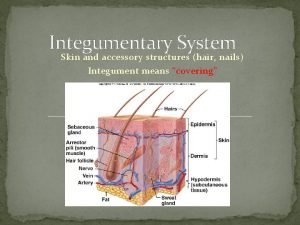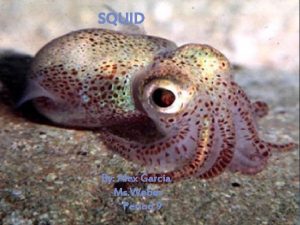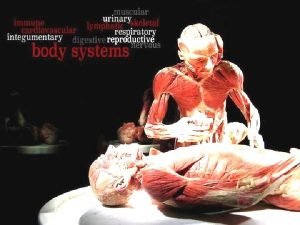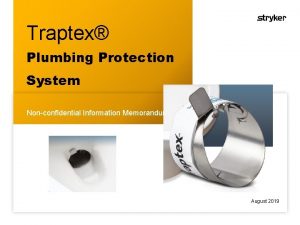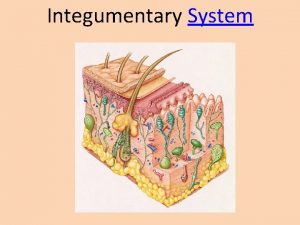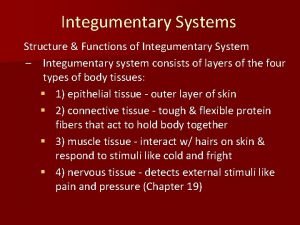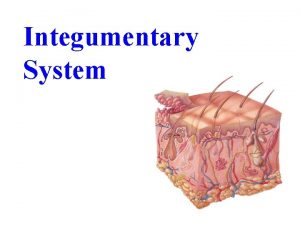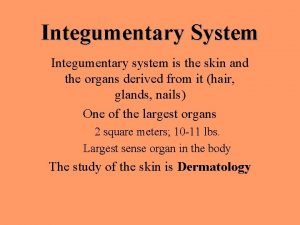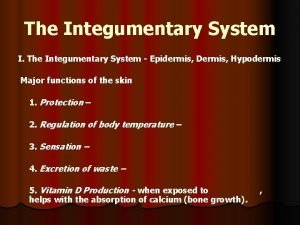Integumentary System Integumentary Functions Protection Temperature maintenance Storage

















































- Slides: 49

Integumentary System

Integumentary Functions • • • Protection Temperature maintenance Storage of nutrients Sensory reception Excretion and secretion

Integument Functions Protection -

Integument Functions • Sensory reception

Integument Functions, con’t • Temperature maintenance – Warm reception • Temperatures above 77° F (25° C) up to 113° F (45° C). • Which also triggers pain receptors – Cold reception • Temperatures between 50° F (10° C) to 68° F (20° C). • Under 50° F the pain receptors are triggered. • Both receptors function at temperatures in between and rapidly adapt

Integument Functions, con’t • Storage of Nutrients –Vitamin D-3 The epidermal layer of the skin. Vitamin D-3 production is greatest in the stratum basale (colored in the illustration) and stratum spinosum (colored orange).

Integument Functions, con’t • Excretion and Secretion

Skin: Structure • Two Layers: – Epidermis • outermost & thinnest • cells are very tightly packed – Dermis • deep & thick • primarily connective tissue • loosely packed • Hypodermis (adipose tissue) – Deep to the skin/dermis – Layer of insulation

Epidermis • Specialized cells within epidermis: – Melanocytes • Melanin: pigment, inc. w/sun (protection) – Keratinocytes • Keratin: tough, waterproof material; abrasion resistance for cells

Epidermis

• Stratum corneum – Dry, dead, keratin filled cells – top layer • Stratum Lucidum – Only on “thick” epidermis at soles and palms – Cells produce keratin • Water resistant – Found in nails, skin and hair • Stratum granulosum – Most cells stop dividing – Cells produce enzymes and proteins • Stratum Spinosum – Cells continue to divide • Statum germinativum/basale – Deepest layer – Cells undergoing mitosis, move up – Contain pappilla – ridges • Ridge pattern continues to surface (finger prints) Epidermis


Skin Color- depends on 2 factors 1. Pigmentation – Carotene- orange/yellow (like carrots) – Melanin – brown, yellow-brown or black – Both increase in response to light • Melanin absorbs UV light • Melanin clusters around nucleus to protect DNA • Ratio of melanocytes to basal cells: 1: 4 TO 1: 20 depending on location • Race differences due to quantity of melanin produced not different ration of cells


Skin Color- depends on 2 factors, con’t • Dermal Circulation – Oxygenated blood is very red – Red blood shows well in lightly pigmented people – Activity shows redder capillaries dilate) – Cyanosis – blue color appears when circulation altered • Cold, heart failure, shock

Vitamin D 3 • Found in epithelial cells • Absorb UV rays which would harm DNA • Converts to calcitrol – Allows calcium and phosphorus absorption in small intestines

• Layers Dermis – Papillary • Supports and nourishes the epidermis • Contains the capillaries and nerves for skin surface – Reticular • Support and attachment for dermis • Allows flexibility and independent movement – Other components • • • Hair follicles Sweat gland Blood vessels Lymphatic Nerve fibers Dermal ridges

Subcutaneous Layer • • • Not actually part of the integument Stabilizes skin to tissues and organs Also called hypodermis Tends to be connective tissue with fat cells Location depends on sex Very elastic Where injections are usually given

Dermis • Specialized Structures (continued) – Arrector pili: tiny, smooth muscle attached to base of dermal papillae & side of hair follicle • Contracts: pulls on both simultaneously>>goosebumps

Accessory Structures Hair Follicles §Not found on palms, soles, sides of fingers or toes, lips, portions of external genitals §Found deep in dermis and into subcu §Shaft: portion above the skin surface: totally keratinized §Functions §Protections from UV rays §Cushions light blows to head §Prevents entry of foreign particles §Sensory nerve at base of follicles (skin sensitivity

Accessory Structure, con’t • Hair Color – Depends on type and amount of pigment – Depends on hormones – Depends on environmental conditions – Pigment decreases with age – White hair = air bubbles within the shaft


• • • Accessary structures, con’t Sebaceous glands Secrete waxy, oily secretion – sebum Ducts to hair follicle Lubricates hair shaft Low p. H prevents bacteria growth large sebaceous glands may lead to acne (blocked which leads to bacteria) Sensitive to sex hormones – Very active during puberty


Accessory Structures, con’t Sweat glands • Apocrine glands-armpits, nipples and groin – Secrete sticky, cloudy, smelly when bacteria breaks it down – Works with hair follicles • Merocrine glands – Discharge directly to surface – Function is to cool the skin – Clear secretion – 99% water

Accessory Structures, con’t • Nails – Protects exposed tips of digits – Nail root – where cell production ocurs – Cuticle – exposed stratum corneum – Luula – moon where blood can’t be seen – Nail body – recessed nail

Aging and the Integument • Skin injuries and infections become more common • Sensitivity of immune system is reduces • Muscles become weaker and bone strength decreases • Sensitivity to sun exposure increases • Skin becomes dry and scaly • Hair thins and changes color

Aging and the Integument, con’t • • Integument weakens and sagging and wrinkling occur Ability to lose heat lessens Skin repairs happen slowly Secondary sexual characteristics in hair and body fat distribution begin to fade

Review Sites http: //cwx. prenhall. com/bookbind/pubbooks/m artini 6/chapter 5/labeling 1/deluxecontent. html http: //cwx. prenhall. com/bookbind/pubbooks/m artini 6/chapter 5/deluxe. html


First Degree Burn: Epidermis only

First Degree Burn

First Degree Burn


Second Degree Burn: Epidermis and upper layers of the dermis

Second Degree Burn



Third Degree Burn: Complete destruction of the epidermis & dermis

Third Degree Burn

Third Degree Burns

Third Degree


Skin graft donor site: about halfway through the initial healing stage

Skin Cancers


Regeneration and Repair • WOW stuff


More Help: General information
 6 functions of the integumentary system
6 functions of the integumentary system Motor winding temperature protection
Motor winding temperature protection Mammalian diving reflex
Mammalian diving reflex Thermoregulation
Thermoregulation Storage and maintenance of drugs
Storage and maintenance of drugs Data storage maintenance
Data storage maintenance Difference between curie temperature and neel temperature
Difference between curie temperature and neel temperature Difference between curie temperature and neel temperature
Difference between curie temperature and neel temperature Difference between curie temperature and neel temperature
Difference between curie temperature and neel temperature Cold chain short note
Cold chain short note Primary storage vs secondary storage
Primary storage vs secondary storage Storage devices of computer
Storage devices of computer Uses rigid metallic platters
Uses rigid metallic platters Unified storage vs traditional storage
Unified storage vs traditional storage Epidermis
Epidermis Integumentary system vocabulary
Integumentary system vocabulary Swine integumentary system
Swine integumentary system Definisi sistem integumen
Definisi sistem integumen The integumentary system facts
The integumentary system facts Exercise 7 the integumentary system
Exercise 7 the integumentary system Integumentary system vocab
Integumentary system vocab Integumentary
Integumentary Integumentary system
Integumentary system Integumentary assessment
Integumentary assessment Integumentary system analogy
Integumentary system analogy Cat integumentary system
Cat integumentary system The integumentary system
The integumentary system Integumentary system components
Integumentary system components Effects of aging on the integumentary system
Effects of aging on the integumentary system Section 36-3 the integumentary system
Section 36-3 the integumentary system Integumentary system
Integumentary system Integumentary system
Integumentary system Unit 3 integumentary system
Unit 3 integumentary system Homeostatic imbalances of skin
Homeostatic imbalances of skin Integumentary system histology labeled
Integumentary system histology labeled Anatomy and physiology of psoriasis
Anatomy and physiology of psoriasis Whats gametes
Whats gametes Integumentary system
Integumentary system Integumentary system
Integumentary system Integumentary system cpt coding guidelines ppt
Integumentary system cpt coding guidelines ppt Integumentary system the integument epidermis coloring page
Integumentary system the integument epidermis coloring page Integumentary system of vertebrates
Integumentary system of vertebrates Integumentary accessory organs
Integumentary accessory organs Integumentary system
Integumentary system Excretory and integumentary system
Excretory and integumentary system Squid integumentary system
Squid integumentary system Body system foldable
Body system foldable Chapter 6 integumentary system
Chapter 6 integumentary system Machine protection systems
Machine protection systems Stryker traptex
Stryker traptex


